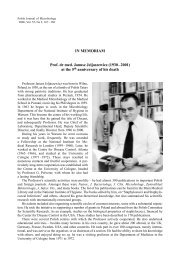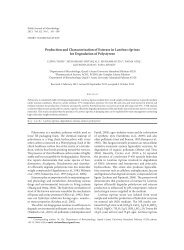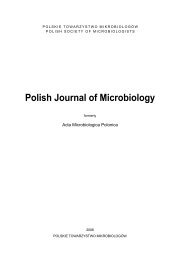No 3 - Polish Journal of Microbiology
No 3 - Polish Journal of Microbiology
No 3 - Polish Journal of Microbiology
You also want an ePaper? Increase the reach of your titles
YUMPU automatically turns print PDFs into web optimized ePapers that Google loves.
214<br />
Experimental<br />
Materials and Methods<br />
Sample collection. Sediment samples were collected<br />
from different stations <strong>of</strong> the pichavaram mangrove<br />
ecosystem (Lat, 11°27’ N; Long. 79°47’ E), situated along<br />
the southeast coast <strong>of</strong> India. Sediment samples were<br />
collected from rhizosphere areas <strong>of</strong> mangrove plants.<br />
The central portion <strong>of</strong> the 5–15 cm sediment sample<br />
was taken. This sample was then transferred to a sterile<br />
bag and transported immediately to the laboratory.<br />
Isolation <strong>of</strong> mangrove actinomycetes. The samples<br />
thus collected were air dried aseptically. After a week,<br />
sediment samples were incubated at 55°C for five minutes<br />
in order to facilitate the isolation <strong>of</strong> Actinomycetes.<br />
Then tenfold serial dilution was prepared with one<br />
gram <strong>of</strong> sediment sample using filtered and sterilized<br />
50% seawater. Samples were inoculated on the starch<br />
casein agar plates in triplicate petriplates. Nalidixic acid<br />
(20 µg/ml) and cycloheximide (50 µg/ml) were added<br />
to the medium in order to retard the growth <strong>of</strong> bacteria<br />
and fungi, respectively. All the plates were incubated<br />
at 28 ± 2°C, and observed from 5 th day onwards for<br />
25 days. Colonies with suspected Actinomycetes morphology<br />
were purified using yeast extract-malt extract<br />
agar medium. The pure cultures <strong>of</strong> the Actinomycetes<br />
were maintained as slant culture on ISP2 agar as well<br />
as in glycerol broth at 4°C.<br />
Screening <strong>of</strong> mangrove isolates for L-asparaginase<br />
production by rapid-plate assay. The isolates were<br />
screened for asparaginase activity using the method <strong>of</strong><br />
rapid plate assay (Gulati et al., 1997). The medium used<br />
was modified M-9 media with pH indicator (phenol<br />
red). L-asparaginase activity was identified by formation<br />
<strong>of</strong> a pink zone around colonies. Two control plates<br />
were also prepared using modified M-9 media – one<br />
was without dye while the other was without asparagine.<br />
All plates were incubated at 30°C. Pink zone<br />
radius and colony diameter were measured from positive<br />
isolates after 48 hrs.<br />
Identification <strong>of</strong> the selected L-asparaginase positive<br />
Actinomycetes. The large pink zone formed isolate<br />
was taken for further characterization. The microscopic<br />
characterization was done by cover slip culture method<br />
(Kawato and Sinobu, 1979). The mycelium structure,<br />
color and arrangement <strong>of</strong> conidiospore and arthrospore<br />
on the mycelium were observed through the oil immersion<br />
(1000X). The observed structure was compared<br />
with Bergey’s manual <strong>of</strong> determinative bacteriology,<br />
ninth edition (2000). Various biochemical tests were<br />
performed for the identification <strong>of</strong> the potent isolate.<br />
Hydrogen sulphide production, citrate utilization,<br />
coagulation <strong>of</strong> milk (Cowan, 1974), catalase test (Jones,<br />
Usha R. et al. 3<br />
1949), melanin pigment (Pridham, 1957), nitrate reduction<br />
(Gordon, 1966). The utilization <strong>of</strong> different carbon<br />
and nitrogen sources (Pridham, 1948). Cell wall was<br />
performed by the method <strong>of</strong> Lechevalier (1968). The<br />
cultural characteristics were studied in accordance with<br />
the guidelines established by the International Streptomyces<br />
Project (Shirilling, 1966).<br />
Production <strong>of</strong> L-asparaginase. An amount (100 ml)<br />
<strong>of</strong> tryptone glucose yeast extract (TGY) broth (production<br />
medium, pH 7.0) comprising <strong>of</strong> glucose, 0.1 g;<br />
K 2 HPO 4 , 0.1 g; yeast extract, 0.5 g; tryptone, 0.5 g; water,<br />
to 100 ml, and contained in a 250 ml Erlenmeyer flask,<br />
was inoculated separately with the screened isolates and<br />
incubated at 28°C in a shaker-incubator oscillating at<br />
200 rev/min for 24 h. At the end <strong>of</strong> the fermentation<br />
period, the crude enzyme was prepared by centrifugation<br />
at 1000x g for 20 min. The cell-free supernatant was<br />
taken as the crude enzyme.<br />
Enzyme assay. L-asparaginase activity was determined<br />
by measuring the amount <strong>of</strong> ammonia formed<br />
by nesslerization (Wriston and Yellin, 1973). 0.5 ml<br />
sample <strong>of</strong> crude enzyme, 1.0 ml <strong>of</strong> 0.1 M sodium borate<br />
buffer (pH 8.5) and 0.5 ml <strong>of</strong> 0.04 M L-asparagine solution<br />
were mixed and incubated for 10 min at 37°C. The<br />
reaction was then stopped by the addition <strong>of</strong> 0.5 ml <strong>of</strong><br />
15% trichloroacetic acid. The precipitated protein was<br />
removed by centrifugation, and the liberated ammonia<br />
was determined by direct nesslerization.<br />
Suitable blanks <strong>of</strong> substrate and enzyme-containing<br />
samples were included in all assays. The yellow color<br />
was read in a spectrophotometer (Shimadzu UV2450)<br />
at 500 nm. One unit (U) <strong>of</strong> L-asparaginase activity is<br />
that amount <strong>of</strong> enzyme, which liberates 1 μmole <strong>of</strong><br />
ammonia in 1 min at 37°C.<br />
Screening <strong>of</strong> important nutrient components<br />
using Plackett-Burman design. This study was done<br />
by Plackett-Burman design for screening medium<br />
components with respect to their main effects and not<br />
their interaction effects (Plackett and Burman, 1946)<br />
on L-asparaginase production by Streptomycetes sp. The<br />
medium components were screened for eleven variables<br />
at two levels, maximum (+) and minimum (–). According<br />
to the Plackett-Burman design, the number <strong>of</strong> positive<br />
signs (+) is equal to (N+1)/2 and the number <strong>of</strong><br />
negative signs (–) is equal to (N-1)/2 in a row. A column<br />
should contain equal number <strong>of</strong> positive and negative<br />
signs. The first row contains (N+1)/2 positive signs and<br />
(N-1)/2 negative signs and the choice <strong>of</strong> placing the<br />
signs is arbitrary. The next (N-1) rows are generated by<br />
shifting cyclically one place (N-1) times and the last row<br />
contains all negative signs. The experimental design and<br />
levels <strong>of</strong> each variable is shown in Table I. The medium<br />
was formulated as per the design and the flask culture<br />
experiments were performed. Response was calculated






